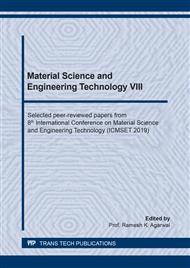[1]
Nogueira, G. F., Fakhouri, F. M., & de Oliveira, R. A. (2018). Extraction and characterization of arrowroot (Maranta arundinaceae L.) starch and its application in edible films. Carbohydrate Polymers, 186 (January), 64–72. https://doi.org/10.1016/j.carbpol.2018.01.024.
DOI: 10.1016/j.carbpol.2018.01.024
Google Scholar
[2]
Capiña, M. V., & Capiña, V. L. L. (2017). Arrowroot (Maranta Arundinacea): Starch Extraction, Processing, and By-Products Utilization. In Proceedings: 4th International Conference on Civil, Environment and Waste Management (CEWM-17) Manila (Philippines).
DOI: 10.17758/uruae.ae0117711
Google Scholar
[3]
Cuevas-Carballo, Z. B., Duarte-Aranda, S., & Canché-Escamilla, G. (2017). Properties and Biodegradability of Thermoplastic Starch Obtained from Granular Starches Grafted with Polycaprolactone. International Journal of Polymer Science, (2017).
DOI: 10.1155/2017/3975692
Google Scholar
[4]
Yu, Y., Cheng, Y., Ren, J., Cao, E., Fu, X., & Guo, W. (2015). Plasticizing effect of poly(ethylene glycol)s with different molecular weights in poly(lactic acid)/starch blends. Journal of Applied Polymer Science, 132(16).
DOI: 10.1002/app.41808
Google Scholar
[5]
Surendra Babu, A., & Parimalavalli, R. (2014). Effect of Starch Isolation Method on Properties of Sweet Potato Starch. Annals of the University Dunarea de Jos of Galati, Fascicle VI: Food Technology, 38(1), 48–63.
DOI: 10.35219/foodtechnology
Google Scholar
[6]
Nogueira, G. F., Fakhouri, F. M., & de Oliveira, R. A. (2018). Extraction and characterization of arrowroot (Maranta arundinaceae L.) starch and its application in edible films. Carbohydrate Polymers, 186 (January), 64–72. https://doi.org/10.1016/j.carbpol.2018.01.024.
DOI: 10.1016/j.carbpol.2018.01.024
Google Scholar
[7]
Roy, S. B., Shit, S. C., Sengupta, R. A., & Shukla, P. R. (2015). Biodegradability Studies of Bio-Composites of Polypropylene Reinforced By Potato Starch, 1120–1130.
Google Scholar
[8]
Li, M., Witt, T., Xie, F., Warren, F. J., Halley, P. J., & Gilbert, R. G. (2015). Biodegradation of starch films: The roles of molecular and crystalline structure. Carbohydrate Polymers, 122, 115.
DOI: 10.1016/j.carbpol.2015.01.011
Google Scholar
[9]
Torres, F., Heros O., Torres, C., Díaz, D.A., & Amaya, E. (2011). Biodegradability and mechanical properties of starch films from Andean crops. International journal of biological macromolecules. 48. 603-6. 10.1016/j.ijbiomac.2011.01.026.
DOI: 10.1016/j.ijbiomac.2011.01.026
Google Scholar
[10]
G. Maglio, A. Migliozzi and R. Palumbo, Polymer, 2003, 44, 369–375.
Google Scholar
[11]
Tsuji, H., Suzuyoshi, K., Tezuka, Y., & Ishida, T. (2003). Journal of Polymers and the Environment, 11(2), 57-65.
DOI: 10.1023/a:1024271805703
Google Scholar
[12]
Oduola, M. K., & Akpeji, P. O. (2015). Effect of Starch on the Mechanical and Rheological Properties of Polypropylene. American Journal of Chemical Engineering, 3(2-1).
Google Scholar
[13]
Sapei, L., Padmawijaya, K.S., Sijayanti, O., Wardhana, P. J. (2015). The effect of banana starch concentration on the properties of chitosan- starch bioplastics. Journal of Chemical and Pharmaceutical Research, 7(9S): 101-105.
DOI: 10.1088/1757-899x/223/1/012044
Google Scholar


